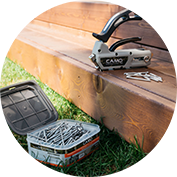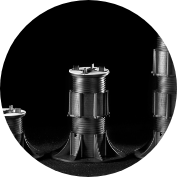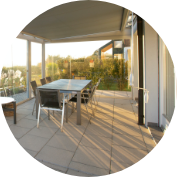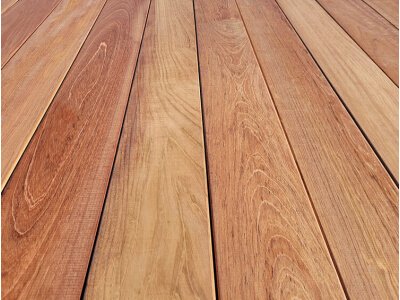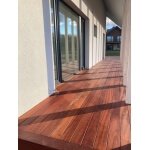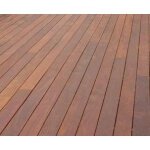Hardwood Decking Jatoba is an extremely dense and durable exotic wood originating from South America. It is often called “Brazilian cherry” due to its strength and aesthetic appeal. Jatoba boards are characterized by rich reddish-brown tones that develop a deeper cherry color over time. Due to its natural resistance to rot, insects and extreme weather conditions, Jatoba is an excellent choice for both indoor and outdoor projects.
Characteristics.
This hardwood species is distinguished by its tropical, elegant wood patterns. The surfaces of Jatoba hardwood planks can have darker stripes, giving them an exotic, unique design. Due to its natural oiliness, the wood is resistant to rot and does not require additional chemical impregnation. It is also extremely resistant to impact and abrasion, making it perfect for areas with heavy traffic.
Features.
Extremely durable , dense and wear-resistant wood.
Tropical color variation – can start from light pink to rich brown, which darkens to warm cherry hues.
Resistant to environmental influences: moisture, insects, mold and extreme weather conditions.
The wood is 2-3 times harder than red oak.
The density of the wood is so high that the boards can sink in water.
It is fire resistant and meets international safety standards.
Jatoba hardwood decking boards can withstand heavy loads and are extremely durable .
Suitable for both indoor and outdoor use – a great choice for patios, stairs, decks and outdoor furniture.
Hardwood decking boards Jatoba. Maintenance.
Jatoba is easy to maintain, but it is recommended to apply WOCA natural color oil or WOCA pigmented oil once a year to preserve and emphasize the natural color of the wood. Oiled boards are also less likely to crack.
Installation.
It is recommended to double the lags at the front and back of the structure, and the following gaps between the lags are 35 – 40 cm to control the curling of the ends of the boards. Doubling the lags is also mandatory at the joint lines of the boards. For fastening, you can use A4 direct fasteners through the top of the board, invisible stainless steel invisible fasteners such as CAMO or Fastshifter or special invisible fastening from below. The recommended gap between the boards is 7 mm ( a spacer is used).
It is recommended to pre- drill screw holes to prevent splitting and cracking. Use only stainless steel screws or fasteners . Avoid contact with corrosive metal objects, which can cause difficult-to-remove blue-black stains on the wood.
Fasteners recommended by MDS experts:
Concealed fastening to a wooden frame
Hidden fixing latch – universal (for wooden, hardwood, thermo or aluminum frames)
Expandet a4 4.8×75 – directly over the top of the board
Recommended.
Leave gaps between the boards (about 7 mm) to ensure proper ventilation and natural movement of the wood.
Use concealed fastening with stainless steel screws.
It is advisable to store the boards outdoors, protected from direct sunlight and precipitation, until installation begins, so that they can acclimatize .
If open mounting systems are used, it is important to use high-quality screws that are resistant to corrosion.
Adaptation.
Jatoba decking boards are extremely versatile and suitable for both residential and commercial spaces:
For terraces – gives a natural and elegant look.
For facades and finishes – durability and natural resistance to weather conditions.
Outdoor furniture and benches – durability and aesthetics.
For public spaces – restaurant terraces, parks and pedestrian paths.
For pool areas – moisture resistance and non-slip texture ensure safety.
For piers and stairs – stability and resistance to deformation.
Longevity.
Jatoba wood is valued for its durability. With proper care, it can last 25 years or more, even in adverse weather conditions. Jatoba decking adds a luxurious and natural look to any outdoor space. Due to its extraordinary hardness and resistance to environmental factors, it is one of the best investments in quality outdoor flooring.
 Hardwood decking board FAVA Amargosa 21x145x4600
44,69 € / pcs
Hardwood decking board FAVA Amargosa 21x145x4600
44,69 € / pcs
 CAMO Drive tool + bag
CAMO Drive tool + bag
 Prodeck Premium WPC decking boards
31,86 € – 60,35 € / pcs
Prodeck Premium WPC decking boards
31,86 € – 60,35 € / pcs
 Solid larch beam 50x100x6000
43,56 €
Solid larch beam 50x100x6000
43,56 €





